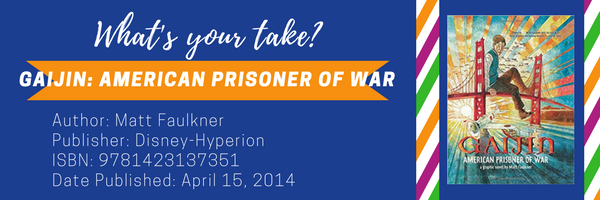Continuing the conversation around “Rethinking conceptual otherness in history: Exploring untold histories in the U.S. and global communities,” Michele Ebersole and Yoo Kyung Sung give their takes on Gaijin: American Prisoner of War by Matt Faulkner. They began the discussion with A Diamond in the Desert by Kathryn Fitzmaurice and Bronze and Sunflower by Cao Wenxua. Next week, they will discuss Lion Island: Cuba’s Warrior of Words by Margarita Engle.

MICHELE: This graphic novel takes a very different perspective on the Japanese internment or relocation camp experience. Koji and his mother live peacefully in San Francisco and their world is turned upside down after the bombing of Pearl Harbor. Since Koji’s mother is white and his father is of Japanese ancestry residing in Japan, Koji is caught between both worlds and not accepted in either one. As my 16-year-old son succinctly stated while reading this novel, “Wow, it sucks to be called Jap in one place and then go to another and called Gaijin [outside person, non-Japanese, foreigner].”
Through powerful images and dialogue, this novel evokes strong emotions and quickly targets the tension for Koji, a half-white, half-Japanese adolescent who is no longer accepted by his white friends in San Francisco and forced to live in a Japanese internment camp during World War II where he is mistreated by a group of young Japanese boys. Although the book explains why his family may be under suspicion, a young reader can immediately feel the injustice for Koji and his mother. Koji is marginalized and alienated by both cultures and isn’t accepted in either world.
This brings to light the struggle for the children of “mixed” racial ancestry during that time period that isn’t often told. Most of the books that we read about the internment camps have reflected the Japanese experience, like A Diamond in the Desert. Those stories are told from the perspective of one who is of Japanese ancestry and highlight the concept of gaman–how the Japanese endured the internment experience with dignity. While the young adolescent main character in that story expresses anger while being interned, it doesn’t necessarily directly depict the rage and injustice that Koji feels in this story. These two novels would make an excellent pairing for literature discussion with adolescent readers.
YOO KYUNG: This story reminds me of the danger of binary perspectives in fiction. In the literary binary world, there are two groups. Jewish people and Nazis, black and white, Japanese and American, etc. Other victims of similar targeting under Nazi rule include people with disability, different sexuality, gypsies (or Roma), etc. We don’t hear about those people often in WWII stories.
Biracial Japanese Americans are also forgotten groups who were nevertheless victims of Japanese Incarceration, yet they are overlooked in the contexts of Japanese incarceration, including in books for young people. I am glad this graphic novel illustrates such lookism and one’s identity through visually enhanced texts. It wouldn’t be the same if the book wasn’t a graphic novel. I also appreciate how this graphic novel doesn’t exhaust readers with too much text but a controlled length of text that goes along with illustrations. This graphic novel will engage young readers about Japanese Incarceration. It is not a history of Others (Japanese) but part of American history we should know.
Title: Gaijin: American Prisoner of War
Author: Matt Faulkner
Publisher: Disney-Hyperion
ISBN: 9781423137351
Date Published: April 15, 2014
This is the third installment of August 2017’s My Take/Your Take. To follow the whole conversation, check the WOW Blog every Wednesday.
- Themes: Gaijin: American Prisoner of War, Matt Faulkner, Michele Ebersole, Yoo Kyung Sung
- Descriptors: Books & Resources, My Take/Your Take

Japanese-Mexicans is also often forgotten group…. “Uprooting Community: Japanese Mexicans, World War II, and the U.S. – Mexico Borderlands” (2015) by Selfa A. Chew.
http://www.uapress.arizona.edu/Books/bid2550.htm